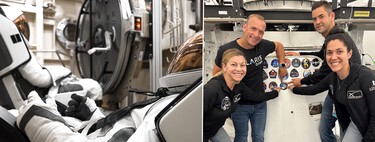SpaceX is set to put four people into a 1,400 km apogee orbit, the farthest from Earth that any human has flown since the last Apollo mission in 1972. The Polaris Dawn mission is coming.
How to watch it live. If there are no delays, the Polaris Dawn mission will lift off on a Falcon 9 rocket at 3:38 a.m. on August 28, local time in Florida. SpaceX will begin a live broadcast three and a half hours before liftoff. The launch will be available to watch on their website and on his official X profileThese are the schedules in different capitals:
- Mexico City: broadcast start at 10:08 pm on August 27, takeoff at 1:38 am
- Bogotá/Lima: broadcast start at 11:08 pm on August 27, takeoff at 2:38 am
- Caracas/Santiago: broadcast start at 12:08 am, takeoff at 3:38 am
- Buenos Aires/Montevideo: start of broadcast at 1:08 am, takeoff at 4:38 am
- Madrid: start of broadcast at 6:08 am, takeoff at 9:38 am
Two additional windows. If the rocket does not take off at 3:38, SpaceX will have two more opportunities to launch on Wednesday: at 5:24 and 7:09. It could also be delayed until Thursday. It was already delayed yesterday due to a helium leak in a ground system. SpaceX is taking extreme precautions on this mission, which is riskier than usual.
The crew. Polaris Dawn has four crew members: Commander Jared Isaacman, who previously flew in space as commander of Inspiration4 and funded this mission; Pilot Kidd Poteet; Mission Specialist Sarah Gillis; and Mission Specialist and Medical Officer Anna Menon.
This will be the first time that SpaceX employees (in this case two female employees) will be part of a manned spaceflight crew.
Why it is important. The four astronauts will travel on the Crew Dragon “Resilience” spacecraft, which already flew on NASA’s Crew-1 mission. The spacecraft will be launched to an altitude of 1,200 km and will climb to 1,400 km with its engines.
During their five-day mission in orbit, the crew will complete several milestones, including the first extravehicular activity in commercial space travel: a spacewalk in the new EVA suits developed by SpaceX. They will also reach the highest altitude of a space flight since the Apollo program.
It will be worth following. Not only because of the spacewalk, which will last two hours and require depressurizing the entire cabin, but because it will be the first ship to test Starlink laser communications in space. We will most likely see incredible live images.
Image | Polaris
At Xataka | A SpaceX flight made its astronauts genetically younger. The intriguing thing is that it lasted only three days














Add Comment